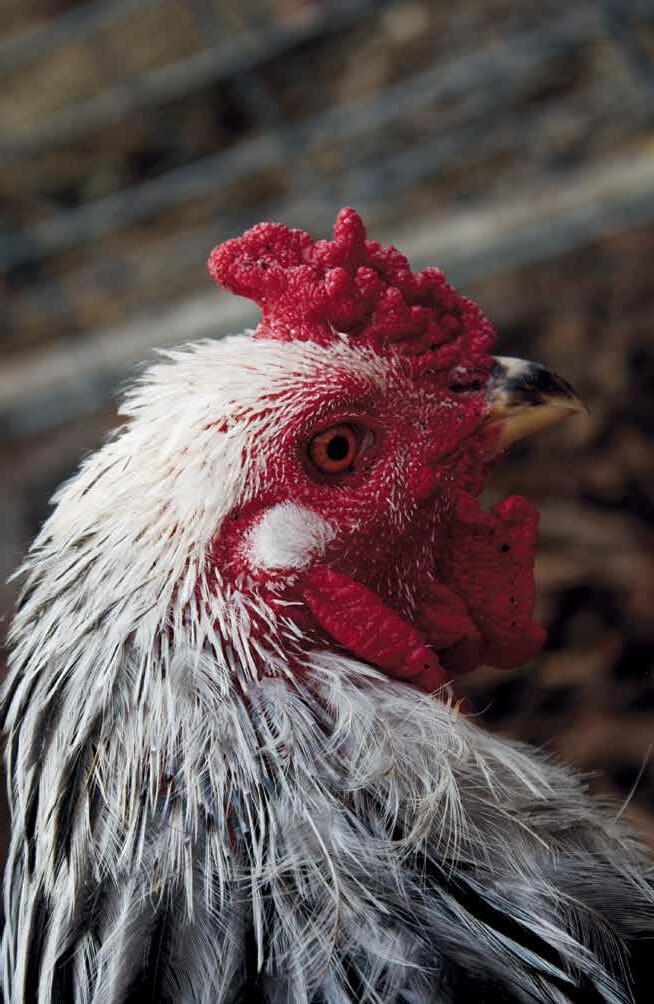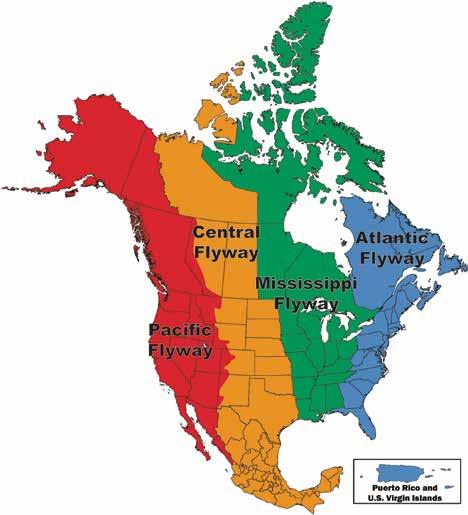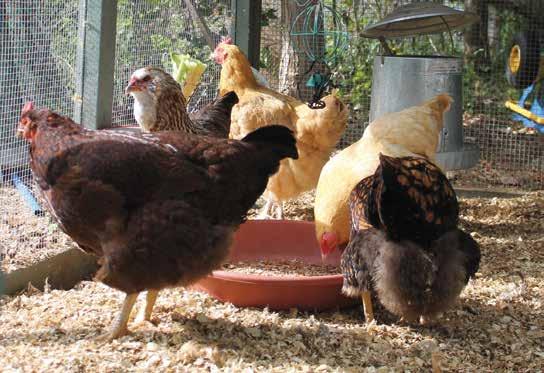
9 minute read
Bird Flu is Back
Bird Flu is Back
Experts say the time is now to take action to prevent a more serious crisis
By Erica Cirino

Ask Connecticut poultry and livestock keepers and birders alike what keeps them up at night, and you’re likely to hear “bird flu.”
More than three years into the latest outbreak of highly pathogenic avian influenza (lethal bird flu) in the United States, Connecticut has—thankfully— seen relatively few cases: 280 total in domestic birds raised for backyard flocks or exhibition since March 2022. Eighty-two wild birds statewide have tested positive for the virus from February 2022 to mid-March 2025. Nationally, however, cases have been far more numerous, with millions of domestic birds and thousands of wild birds infected. Worldwide, lethal bird flu cases have been surging since 2020, and besides Australia, every continent—including Antarctica—has seen cases.
The present epidemic is the latest in a string of increasingly worrying bird flu outbreaks to strike the U.S. and the world. While experts stress that most people are not in immediate danger of infection, and there is much bird-keepers can do to keep themselves safe, the longer bird flu sticks around, the more that virus’s dangers are evolving in worrying ways, infecting not only birds, but many other animals, including people.
From Wild Birds to Poultry and Back Again
The last major outbreak of bird flu in the United States lasted from 2014 to 2015. Some 50 million domestic birds died from the virus or were killed to control it, costing the poultry industry an estimated $3.3 billion, with American poultry farmers losing more than $1.6 billion. The outbreak was finally quelled through mass euthanasia of infected flocks of domestic birds, a push for better hygiene practices on commercial poultry farms and in backyard coops, and close monitoring of wild birds for disease.
The present outbreak is far more severe. Since December 2021, more than 169 million domestic birds—primarily on commercial farms, and in backyard and exhibition flocks—have tested positive for so-called “H5” strains of the virus. As during the previous epidemic, once an infection is detected, all birds in an exposed flock are quickly euthanized to help quell the spread of the virus. More than 13,000 wild birds, primarily waterfowl like ducks and geese, have also tested positive.
Connecticut may appear to have few cases because it lacks a high concentration of commercial poultry farms. Commercial poultry operations, most of which are concentrated in the Midwest and Southeast, can house tens of thousands to millions of birds in high-density living conditions ripe for the spread of disease.

Yet five backyard bird-keepers in New Haven and New London counties were hit. Backyard birds, especially those who are kept free-range, are vulnerable to bird flu; all it takes for them to get sick is contact with infected birds, their feces, or infected food or water. Usually in these cases, it’s wild birds that have spread the virus to domestic flocks.
“Avian influenza likely entered the state via wild migratory birds as they moved between states and across North America,” said Will Healey, director of communications at the Connecticut Department of Energy & Environmental Protection (DEEP). “(Among wild birds) the outbreaks tend to be most severe during the winter when wild migratory birds are congregating in large numbers, disease is easily transmitted from bird to bird, and some birds may be in poorer body condition, and thus more susceptible to infection. As temperatures rise, we often see less mortality in wild birds as they begin to disperse, are not in close contact with one another, and are less challenged by adverse weather and other stressors on their overall health.”
Globally, migratory birds travel along nine overlapping “flyways” stretching north to south. Bird flu can spread rapidly among migratory birds, particularly when they congregate at their feeding grounds during the winter, and sometimes at high-traffic water sources, like lakes and ocean shorelines, during summer breeding season. From these busy areas, wild birds travel on these overlapping travel routes and can spread the virus far and wide.

Bird flu is an influenza-A type virus which normally disperses seasonally in a far less deadly “low-pathogenic” form among wild birds, particularly waterfowl. Older, injured, or already sick birds may become very ill from low-pathogenic bird flu, but healthy birds usually recover. Domestic birds are sickened through interactions with infected wild birds and their feces, or contaminated air, farm equipment, food, soils, or waters.
The best strategy to mitigate the development of more virulent strains of bird flu is preventing the virus from spreading.
It is through the repeated exchange of bird flu viruses between wild and domestic birds that low-pathogenic strains of bird flu tend to develop into more lethal subtypes. And the crowded living conditions typical on commercial poultry farms create an incubator for disease, enabling viruses to survive, multiply, and mutate into more lethal forms. A pattern of increasingly serious infection and mutation enables more virulent strains of bird flu to emerge and spread from wild birds to domestic birds, and back again.
Lethal Bird Flu Goes Beyond Birds
Globally, the current outbreak is wreaking unprecedented havoc on nonhuman mammals. In the U.S., H5 strains’ newer subtypes have spread lethal bird flu to more than 200 mammals since May 2022, including bears, dairy cows, domestic and wild cats, foxes, raccoons, and many others. In Connecticut, two bobcats—in Fairfield and Windham counties—tested positive for bird flu. And for the first time, bird flu has jumped from nonhuman mammals to infect at least 70 people, many of whom work on poultry and dairy farms.
Decades ago, it was rare for bird flu to infect mammals, unless an animal consumed an infected bird or was exposed to environments contaminated with the virus. Now, bird flu infections in mammals are becoming more frequent and could be making the virus more deadly. The subtype of bird flu now circulating among dairy cows seems particularly contagious; it has spread to 17 states and is responsible for the death of a Louisiana resident.
Worryingly, researchers at the University of Wisconsin at Madison and in Japan found that they could infect ferrets and mice with lethal bird flu virus that had sickened a person who had become infected through contact with dairy cows. What’s more, they found that this virus readily spread through the air to ferrets living in separate cages, and appeared capable of binding to and replicating in human lung cells.
“Based in these observations, every effort should be made to contain HPAI (highly pathogenic avian influenza) H5N1 outbreaks in dairy cattle to limit the possibility of further human infections,” the researchers wrote in the journal “Nature” in October 2024.
In another study, scientists at Scripps Research discovered that an additional single mutation on the surface protein of the lethal bird flu subtype circulating among dairy cows could make it easier to transmit among people. In our post-COVID world, the consequences of highly virulent zoonotic diseases are now well-known to most people. It and earlier bird flu outbreaks, which infected and killed millions of people, serve as a warning of what could occur should H5 lethal bird flu continue to mutate in ways favorable to human infection.
Why Bird Flu Keeps Coming Back‚ and How to Stop It
Worldwide, the U.S. and other regions in the Global North deal with bird flu by stressing the need for good farm hygiene—cleaning farm equipment and birds’ living quarters, sanitizing boots, and quarantining sick animals, among other measures—and disease eradication through rapid euthanasia. Other countries with many outdoor industrial farms, typically in the Global South, struggle with separating domestic birds from their wild counterparts and may lack veterinary care so diseases are allowed to circulate, sometimes with use of vaccines to lessen illness and death. However, experts say animal vaccines do not prevent birds from bird flu infection or from shedding the virus, and so, it persists.
Meanwhile, research shows that chickens are stressed by the overcrowded living conditions typical on both indoor and outdoor commercial farms, which reduces immunity and increases susceptibility to disease. Establishing networks of smaller farms where animals have more space—and farms have reduced needs for transporting animals, equipment, and workers—are other ways to keep animals healthier and disease at bay.
As bird flu outbreaks become more common and worrisome, some experts think a vaccine will be necessary to protect people from another zoonotic pandemic. Scien-tists had been working on a vaccine, but in May the federal government announced it was cancelling a $766 million contract with Moderna citing “safety concerns” and “a shift in federal vaccine funding priorities.” This means, for now, it’s up to consumers and producers to help slow the spread of the virus.
“At the height this year, I had a water and bleach solution that I would dip my boots in before going into the run,” said Kelly Boyle, a licensed National Poultry Improvement Plan chicken breeder based in Willington. “I also sprayed the feed bag with rubbing alcohol to kill anything that was picked up at the store or in transit.”
In addition, the Connecticut State Department of Agriculture tests her flock for bird flu every three months.
Knowledge, preventative action, and vigilance are critical to preventing further infec-tions. But ultimately what’s also needed is widespread improvements to the lives and health of poultry and livestock on large high-density animal farms. Making such a necessary change will require reevaluating our relationships with the animals we rely up-on for our survival and the realization that their wellbeing is directly connected to our own.
Slowing the Spread of Bird Flu
Purchase eggs and meat from small, local producers rather than large, commercial farms. Thoroughly cook all poultry.
Isolate domestic flocks from wild birds such as ducks and geese.
Avoid direct contact with sick birds and other livestock and their bedding. Wear personal protective gear such as gloves and masks when handling infected or deceased animals.
Practice good hygiene, including frequent hand washing.
Consume only pasteurized milk and other dairy products. (Pasteurization kills the virus).
Report sick poultry, an unexplained high number of deaths, a sudden drop in egg production, or a sudden reduction in feed or water intake to the State Veterinarian at 860-713-2505 or ctstate.vet@ct.gov.
Erica Cirino is a writer and artist who explores the intersection of the human and more-than-human worlds. She serves as communications manager at the nonprofit Plastic Pollution Coalition and is best known for her widely published photojournalistic works, including her award-winning book, Thicker Than Water: The Quest for Solutions to the Plastic Crisis.





